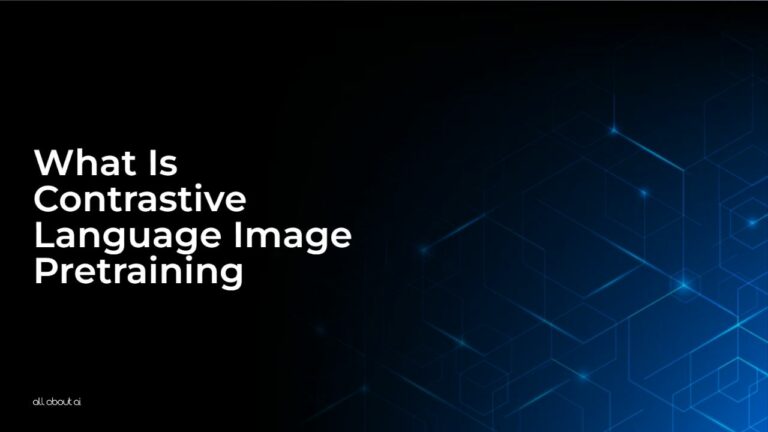Contrastive Language Image Pretraining (CLIP) is a cutting-edge concept; however, what exactly is Contrastive Language Image Pretraining? Simply put, it involves training models to understand and generate content by simultaneously learning from language and images. In essence, it leverages the power of both linguistic and visual data to enhance the capabilities of AI systems. This interdisciplinary approach marks a significant advancement in the field, bridging the gap between natural language processing and computer vision.
Looking to learn more about Contrastive Language Image Pretraining? Read this article written by the AI experts at All About AI.
Examples of Contrastive Language Image Pretraining
Virtual Assistants: Traditional virtual assistants often struggle with interpreting complex queries, especially those involving visual elements. CLIP enables these AI systems to not only comprehend spoken commands accurately but also to understand the context through accompanying visual cues. For instance, a virtual assistant equipped with this technology can seamlessly interpret and respond to requests like, “Find me a recipe for this dish” by analyzing both the spoken description and associated images.
Healthcare: The healthcare sector has witnessed transformative applications of CLIP, particularly in medical imaging. This technology plays a pivotal role in the analysis of diagnostic images, aiding healthcare professionals in making more accurate and efficient diagnoses. By simultaneously considering both textual medical reports and the visual content of images, AI systems can recognize subtle patterns and abnormalities that might be challenging for traditional methods.
Autonomous Vehicles: Autonomous vehicles are another domain where CLIP showcases its prowess. The technology significantly improves object recognition and the overall understanding of the surrounding environment by incorporating both linguistic and visual information. In the context of self-driving cars, this means enhanced safety and reliability. AI systems, trained through Contrastive Language Image Pretraining, can more accurately identify and respond to various objects and scenarios on the road, contributing to the development of safer and more efficient autonomous driving capabilities.
Content Generation: Creative content generation benefits from Contrastive Language Image Pretraining, especially in industries like advertising, design, and entertainment. AI systems equipped with this technology can seamlessly generate content that is both linguistically coherent and visually appealing. Whether it’s crafting image captions, telling stories, or even creating visual art, the synergy between language and image understanding leads to more contextually relevant and aesthetically pleasing results.
Use Cases of Contrastive Language Image Pretraining
Healthcare Diagnostics: The integration of CLIP in medical imaging expedites the diagnostic process, enabling AI systems to identify intricate patterns and abnormalities in diagnostic images for more accurate and timely healthcare decisions.
E-commerce Optimization: Implementing Contrastive Language Image Pretraining in e-commerce platforms results in more personalized product recommendations, leveraging both product descriptions and images to enhance user engagement and satisfaction.
Content Creation: Creative industries benefit from CLIP as it facilitates the generation of contextually relevant and visually coherent content, spanning image captions, storytelling, and visual art creation, streamlining and enhancing the creative process.
Pros and Cons
Pros
- Enables AI models to comprehend both linguistic and visual elements simultaneously.
- Contributes to more accurate and context-aware decision-making in various applications.
- Applicable across diverse domains, from healthcare to virtual assistants and creative content generation.
- Accelerates and improves the diagnostic process in medical imaging.
- Enhances the quality of product recommendations in e-commerce.
Cons
- Requires substantial amounts of labeled data for effective training.
- Demands significant computational power for training large-scale models.
- Complex models may lack transparency, making it challenging to interpret their decision-making processes.
- The potential for biased outcomes in decision-making, especially in sensitive domains.
- Implementing CLIP may pose integration challenges in existing systems.
FAQs
How does CLIP Pretraining differ from traditional AI approaches?
Unlike traditional AI methods, CLIP combines language and image data during the training process. This allows models to learn from both modalities simultaneously, leading to more nuanced understanding.
Can Contrastive Language Image Pretraining be applied to real-time applications?
Yes, it can be applied to real-time applications. However, the computational requirements and infrastructure must be capable of supporting the processing demands of simultaneous language and image data.
Does CLIP address bias concerns in AI models?
While it doesn’t eliminate bias entirely, Contrastive Language Image Pretraining provides an opportunity to address and mitigate bias by considering both linguistic and visual contexts in decision-making.
What industries can benefit most from Contrastive Language Image Pretraining?
Healthcare, virtual assistance, e-commerce, autonomous vehicles, and creative content generation are among the industries that can significantly benefit from CLIP.
Key Takeaways
- Contrastive Language Image Pretraining combines language and image data for more comprehensive AI understanding.
- Applications span across healthcare diagnostics, virtual assistants, e-commerce, autonomous vehicles, and content creation.
- Pros include enhanced accuracy, versatility, and efficient diagnostics, while cons involve data intensiveness and interpretability challenges.
- Real-time applications are feasible, but infrastructure considerations are crucial.
- Addressing bias concerns and leveraging the technology’s versatility can maximize its benefits.
Conclusion
Contrastive Language Image Pretraining represents a transformative leap in AI, unlocking the potential for more nuanced and context-aware understanding. Its diverse applications across industries underscore its versatility and impact. As AI continues to evolve, embracing innovative approaches like CLIP is crucial for pushing the boundaries of what AI systems can achieve.
Now that you have the answer to the question, “what is Contrastive Language Image Pretraining,” you can delve deeper and explore more AI-related topics in our expansive AI Encyclopedia at All About AI.





